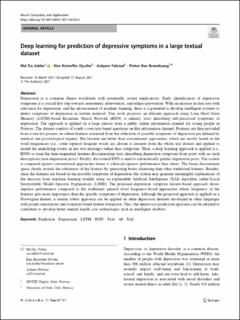| dc.contributor.author | Uddin, Md Zia | |
| dc.contributor.author | Dysthe, Kim Kristoffer | |
| dc.contributor.author | Følstad, Asbjørn | |
| dc.contributor.author | Brandtzæg, Petter Bae | |
| dc.date.accessioned | 2023-02-13T11:43:58Z | |
| dc.date.available | 2023-02-13T11:43:58Z | |
| dc.date.created | 2021-09-01T08:19:43Z | |
| dc.date.issued | 2021 | |
| dc.identifier.citation | Uddin, M.Z., Dysthe, K.K., Følstad, A. et al. Deep learning for prediction of depressive symptoms in a large textual dataset. Neural Comput & Applic 34, 721–744 (2022). https://doi.org/10.1007/s00521-021-06426-4 | en_US |
| dc.identifier.issn | 0941-0643 | |
| dc.identifier.uri | https://hdl.handle.net/11250/3050368 | |
| dc.description.abstract | Depression is a common illness worldwide with potentially severe implications. Early identification of depressive symptoms is a crucial first step towards assessment, intervention, and relapse prevention. With an increase in data sets with relevance for depression, and the advancement of machine learning, there is a potential to develop intelligent systems to detect symptoms of depression in written material. This work proposes an efficient approach using Long Short-Term Memory (LSTM)-based Recurrent Neural Network (RNN) to identify texts describing self-perceived symptoms of depression. The approach is applied on a large dataset from a public online information channel for young people in Norway. The dataset consists of youth’s own text-based questions on this information channel. Features are then provided from a one-hot process on robust features extracted from the reflection of possible symptoms of depression pre-defined by medical and psychological experts. The features are better than conventional approaches, which are mostly based on the word frequencies (i.e., some topmost frequent words are chosen as features from the whole text dataset and applied to model the underlying events in any text message) rather than symptoms. Then, a deep learning approach is applied (i.e., RNN) to train the time-sequential features discriminating texts describing depression symptoms from posts with no such descriptions (non-depression posts). Finally, the trained RNN is used to automatically predict depression posts. The system is compared against conventional approaches where it achieved superior performance than others. The linear discriminant space clearly reveals the robustness of the features by generating better clustering than other traditional features. Besides, since the features are based on the possible symptoms of depression, the system may generate meaningful explanations of the decision from machine learning models using an explainable Artificial Intelligence (XAI) algorithm called Local Interpretable Model-Agnostic Explanations (LIME). The proposed depression symptom feature-based approach shows superior performance compared to the traditional general word frequency-based approaches where frequency of the features gets more importance than the specific symptoms of depression. Although the proposed approach is applied on a Norwegian dataset, a similar robust approach can be applied on other depression datasets developed in other languages with proper annotations and symptom-based feature extraction. Thus, the depression prediction approach can be adopted to contribute to develop better mental health care technologies such as intelligent chatbots. | en_US |
| dc.language.iso | eng | en_US |
| dc.publisher | Springer | en_US |
| dc.relation.uri | https://link.springer.com/article/10.1007/s00521-021-06426-4 | |
| dc.rights | Navngivelse 4.0 Internasjonal | * |
| dc.rights.uri | http://creativecommons.org/licenses/by/4.0/deed.no | * |
| dc.subject | XAI | en_US |
| dc.subject | AI | en_US |
| dc.subject | Text | en_US |
| dc.subject | RNN | en_US |
| dc.subject | LSTM | en_US |
| dc.subject | Depression | en_US |
| dc.subject | Prediction | en_US |
| dc.title | Deep learning for prediction of depressive symptoms in a large textual dataset | en_US |
| dc.type | Peer reviewed | en_US |
| dc.type | Journal article | en_US |
| dc.description.version | publishedVersion | en_US |
| dc.rights.holder | Copyright: The Author(s) 2021 | en_US |
| dc.source.pagenumber | 721-744 | en_US |
| dc.source.volume | 34 | en_US |
| dc.source.journal | Neural computing & applications (Print) | en_US |
| dc.identifier.doi | 10.1007/s00521-021-06426-4 | |
| dc.identifier.cristin | 1930286 | |
| dc.relation.project | Norges forskningsråd: 262848 | en_US |
| cristin.ispublished | true | |
| cristin.fulltext | original | |
| cristin.qualitycode | 1 | |

